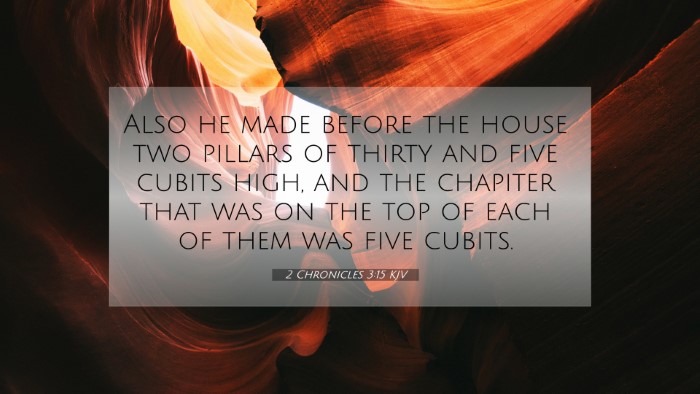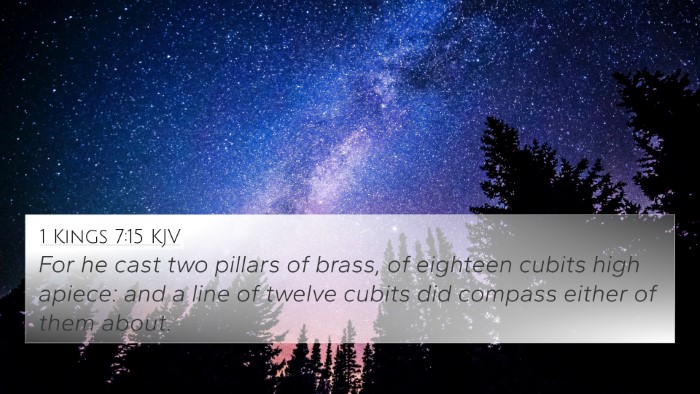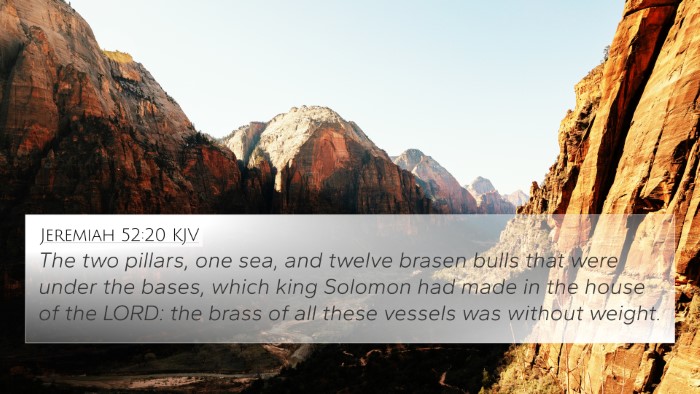Understanding 2 Chronicles 3:15
2 Chronicles 3:15 states:
“Also he made before the house two pillars of thirty and five cubits high, and the chapiter that was on the top of each of them was five cubits.”
Summary of Biblical Significance
This verse describes the construction of the two significant pillars in front of Solomon's Temple. These pillars, named Jachin and Boaz, symbolize God’s strength and establishment, thereby representing crucial theological themes of stability and presence.
Commentary Insights
Matthew Henry's Commentary
Matthew Henry emphasizes the importance of the physical structure of the temple as a manifestation of spiritual truths. The pillars not only bear architectural significance but also serve as a reminder of God’s everlasting covenant with Israel. The heights of the pillars symbolize the exaltation of God’s glory.
Albert Barnes' Notes
Albert Barnes focuses on the dimensions and the craftsmanship involved in the construction of these pillars. He connects their height to the reverence and awe due to the Temple, suggesting that God's dwelling should inspire humility and worship. The chapiters, being five cubits high, indicate the artistry and significance in the overall design, suggesting a divine order in worship.
Adam Clarke's Commentary
Adam Clarke highlights the cultural and historical context of the pillars, relating them to ancient practices of architecture seen in neighboring cultures. He discusses the possible symbolic meanings of the names of the pillars — Jachin means "He shall establish," and Boaz means "In it is strength," reinforcing the idea that the Lord is the foundation of strength and stability for His people.
Thematic Connections
The construction of the pillars in 2 Chronicles 3:15 can be related to several significant biblical themes:
- Divine Presence: The pillars symbolize God's stability and presence among His people.
- Covenant Identity: They represent God's commitment to Israel, linking to Exodus 26:32 where the tabernacle's construction is detailed.
- Worship and Reverence: The physical grandeur of the temple space reflects the appropriate reverence owed to God, connecting to Psalm 29:2.
- Foundation and Strength: The strength represented by Boaz reflects God's eternal foundation for believers, as seen in Psalm 18:2.
- Symbolism of High Places: Elevated structures in biblical texts often denote a connection to heaven, bridging the divine and earthly realms, as seen in Genesis 28:12.
Cross-References
This verse connects with various other biblical texts, providing a deeper understanding:
- 2 Chronicles 3:16 - further details on the chapiters of the pillars.
- 1 Kings 7:21 - mentions the same pillars and their significance in Solomon’s temple.
- Exodus 26:32 - discusses the structure of the tabernacle, setting a precursor for the temple.
- Psalms 78:69 - references the temple, denoting God's choice of Zion.
- Isaiah 28:16 - presents God as a cornerstone, correlating with the foundational aspects of the pillars.
- Jeremiah 51:51 - discusses God's strength against adversaries, paralleling Boaz's meaning.
- Matthew 16:18 - Jesus as the rock signifies the enduring nature of God's establishment through His church.
Conclusion
In summary, 2 Chronicles 3:15 serves as a pivotal verse that ties together themes of divine presence, stability, and the importance of effective worship. The pillars stand not just as architectural achievements but as enduring symbols of God’s commitment to and relationship with His people.
Further Study Tools
If you wish to dive deeper into the connections and meanings of this verse, consider using:
- Bible Concordance: To find specific words and their verse connections.
- Bible Cross-Reference Guide: Navigate thematic and direct links between scriptures.
- Bible Cross-Reference System: For understanding the broader biblical narrative.
- Bible Chain References: Illustrate how verses build upon one another throughout scripture.




